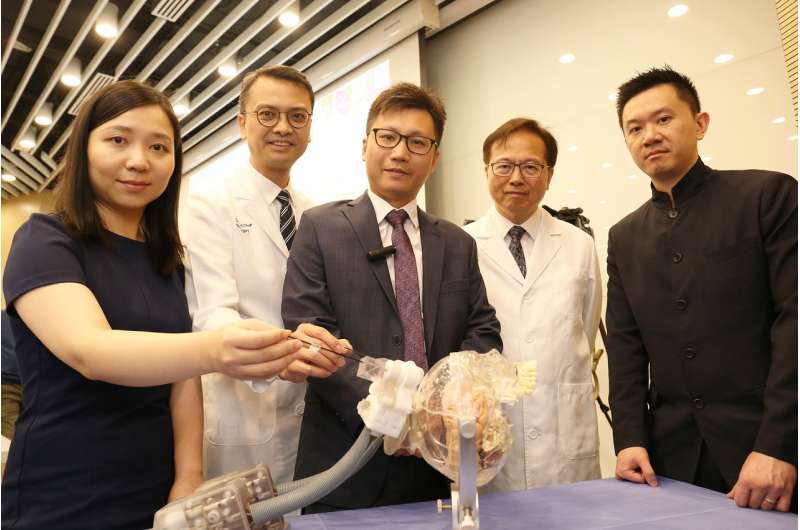A HKU Mechanical Engineering team led by Dr. Kwok Ka-wai recently designed the first neurosurgical robotic system capable of performing bilateral stereotactic neurosurgery inside a magnetic resonance imaging ('MRI') scanner. Credit: The University of Hong Kong
Stereotactic neurosurgery is one of the treatment to a variety of movement and neuropsychiatric disorders, such as Parkinson's disease (PD), essential tremor and major depression. It involves a technique that can locate targets of surgical interest using an external positioning system, which is widely used in brain biopsy, tumor ablation, drug delivery, as well as deep brain stimulation (DBS). Parkinson's disease alone is the second-most common disease of the nervous system after Alzheimer's disease, and is projected to affect over 8.7 million people worldwide by 2030. As such, any improvement to this surgery would benefit a large population.
A HKU Mechanical Engineering team led by Dr. Kwok Ka-wai recently designed the first neurosurgical robotic system capable of performing bilateral stereotactic neurosurgery inside a magnetic resonance imaging (MRI) scanner. The team also conducted preclinical validation of the system with CUHK neurosurgeons, Dr. Danny Chan Tat-ming and Professor Poon Wai-sang. This innovative technological breakthrough can facilitate the treatment of Parkinson's disease and other neuropsychiatric disorders.
DBS therapy, like a heart pacemaker, can deliver electrical signals through implanted electrodes to the deep brain targets. It helps to restore normal nerve cell activity. This surgery demands tremendous accuracy, targeting only the tiny nucleus structures without damaging the surrounding critical tissue. Without the intra-operative updates of a surgical "roadmap," the brain may shift after the skull is opened and inevitably lowers the targeting accuracy. Conventional DBS is performed while the patient is awake under local anesthesia. Surgeons have to rely on verbal or physical interactions with the patients to ensure the electrode placement is going well. These surgical complications motivated the HKU-led team to develop a compact robot guided by MRI. This facilitates less invasive stereotactic procedures on the patient under general anesthesia, as surgeons could accurately control and evaluate the stereotactic manipulation bilaterally to the left and right brain targets in real time.
The team successfully resolved many unmet technical challenges. For example, MRI scanners have very strong magnetic fields and most metallic components are forbidden in MRI environments, including the electromagnetic (EM) motors commonly used in robots. The team has developed a MR-compatible tele-operated system driven by liquid. It does not generate any EM interference or affect imaging quality, even during the robot operation. A manipulator is designed to perform dexterous operation toward the left-and-right brain targets, and the area required for an invasive anchorage is very small. The compact robot design can be accommodated inside a standard MRI head coil for imaging and intervention. The design includes advanced 3-D tracking markers that enable fast localization of the robot instruments through MRI in real time.
The researchers believe that all these components can be applied to other interventions requiring MRI guidance, e.g. cardiac catheterization, prostate or breast biopsy. The research team plans to conduct further clinical studies to determine the efficacy of the system.
Provided by The University of Hong Kong




















